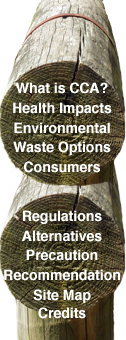Health Impacts
Health-Related Litigation
As could be expected, there has been a number of lawsuits in the US against manufacturers of CCA-treated timber over the last 20 years because of health impacts on consumers and workers. Table 2.4 shows some of the successful cases brought by one lawyer, David McCrea, during the 1980s and 1990s. McCrea uncovered an internal industry memo, dated 1977, which showed that the industry know of the health hazards associated with CCA but failed to inform the public or the EPA about them (McArdle, 2002).
Successful Lawsuits by Indiana lawyer David McCrea
| Plaintiff | Injury | Defendant | Award |
|---|---|---|---|
| 20 defendants | $667,000 | ||
| Parks’ employee who made picnic tables | Elevated levels of arsenic, vomiting blood | Osmose – manufacturer of wood preservative | $100,000 |
| Parks’ employee | Elevated levels of arsenic and nasal bleeding | Osmose | $334,000 |
| Treatment plant worker | Polyps hanging from nose | Osmose | $120,000 |
| County park worker who made walkways | Lost feeling in hands and feet | Wood treating companies | $460,000 |
| Woman who got wood splinter | Two fingers amputated | $150,000 |
Source: McArdle 2002
This failure to inform the public was particularly poignant to McCrea because he remembers building a deck from CCA-treated wood and then using some of the leftover wood to make a fire in his home fireplace for his 5 year old son to play camping. ‘He was this little guy in a yellow jumpsuit with bunny feet on it. The damn stuff was so wet with preservative that it didn’t burn. It made me so mad they could put my son at risk’ (McArdle, 2002).
The threat of class actions is now looming. For example, a class action was filed in January 2005 by workers and residents living near a wood treatment plant operated by Kerr-McGee and the T.P. Corporation in the US. They are alleging that they “developed skin, liver and lung cancer, asthma, leukemia, myeloma and non-Hodgkin's lymphoma due to the release of hazardous chemicals used at the facilities” (Lewis, 2005).
During 2002 at least three class actions were filed against companies producing and applying the CCA preservative and retailers such as Home Depot and Loews (McArdle, 2002; Pianin, 2002). One such class action has been finalised in California. The group filing the law suit alleged that the manufacturers of CCA-treated timber products, such as picnic tables and play equipment, had violated the Safe Drinking Water Toxic Enforcement Act, 1987. This act requires warnings to be placed on products that contain chemicals known by the state to cause cancer or reproductive problems. This included CCA, which is classified as a carcinogen in the US. One outcome of the lawsuit is that 31 manufacturers have agreed to notify purchasers and distributors of CCA-treated products of the potential cancer risks associated with these products. They will also mail advice to purchasers on how to reduce exposure (eg sealing the wood and washing hands after use). Significantly, 28 of these companies agreed to stop selling CCA-treated timber products worldwide (Whetzel, 2003).
Commentators have warned that this could be the ‘next tobacco’ or the ‘next asbestos’, because of the large numbers of people exposed to treated timber who might have a case and the denials of the manufacturers. However the difficulty with CCA-treated timber, as opposed to asbestos, is that the there is no trade mark illness, and people can be exposed to arsenic in a variety of ways so cause and effect are difficult to prove, except where people have been exposed occupationally and even then a lack of medical record-keeping on the part of the companies involved makes this difficult.
Litigation lawyers Natali Junior et al (2003) say that ‘purchasers of CCA-treated wood for use in outdoor decks or playgrounds, individuals injured by virtue of contact with structures made from CCA-treated wood, and contractors who work with CCA-treated wood in the course of their daily activities’ are all potential claimants for CCA-treated timber legal action. Beyond litigation based on health impacts, they describe the potential for environmental litigation for impacts created through arsenic leaching into soil, surface waters or groundwater, and the impacts of waste CCA-treated timber in unlined landfills.
In Australia the potential liabilities for authorities are being discussed but no lawsuits have yet been initiated. Commentating on the ‘lax use and disposal requirements [that] are fundamentally at odds with the basic principles of responsible product stewardship’, the Worldwide Fund for Nature warns that allowing manufacturers and retailers to continue to make and sell CCA-treated timber could become a ‘major liability to authorities’ (Rouse, 2004).
References:
Lewis, E. (2005), ‘Kerr-McGee, Duryea firm named in class-action suit’, The Citizens Voice, 5 January.
McArdle, E. (2002), ‘Arsenic-Treated Lumbr may be Next Wave of Litigation’, Lawyers Weekly USA, 14 October, http://www.lawyersweeklyusa.com/alert/usa/lumber.htm.
Natali Jr., A., Chiafullo, L. and Valladares, R. (2003), ‘CCA-Treated Wood Litigation and Insurance Coverage Issues’, Mealey's Insurance Reports.
Pianin, E. (2002), ‘Arsenic to Be Banned in Home Lumber.’ San Francisco Chronicle. 13 February, p. A-3.
Rouse, A. (2004), ‘WWF Submission on the Australian Pesticides and Veterinary Medicines Authority Review: The Reconsideration of the Registrations of Arsenic Timber Treatment Products (CCA and arsenic trioxide) and Their Associated Labels, Worldwide Fund for Nature’, February 18.
Whetzel, C. (2003), ‘Firms Making Arsenic-Treated Products To Notify California Consumers of Risks’, BNA, March 24, http://www.ewg.org/news/story.php?print_version=1&id=1529 (accessed 1/11/04)


